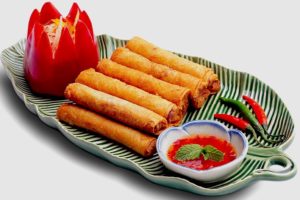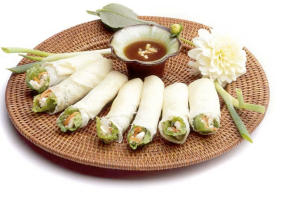
Come with me on a culinary journey home to the Philippines, where I will share with you a sample of Filipino cuisine.
The Philippines consist of over 7,000 tropical islands in which the people are surrounded with an abundant supply of fresh seafood and produce that you can find in backyards and local markets.
The Spaniards ruled the Philippines for over 300 years, so Filipino food was heavily influenced by the Spanish but also many Asian cultures like Chinese, Malaysian and Indonesian flavors. Most of the dishes are named in Spanish like leche flan, menudo, calderta lechon and paella. The Chinese brought their spices, noodles and introduced something like lumpia to the Filipinos.
Indonesians also contributed their version of popular lumpia, more commonly known as spring rolls with their bold and exotic flavors.
Filipino food is a combination of bold flavors, spicy, bitter–pait , salty–alat, sweet–tamis and sour–asim.
There are many different variations of lumpia in the Philippines, mostly depending upon demographics and geography.
The traditional fried lumpia is made with ground beef, vegetables and spices, wrapped in egg roll wrappers, fried to a crisp and then served with spiced vinegar dipping sauce. Shanghai Lumpia is made with ground pork, shrimp and vegetables, fried to crisp and cut up into small pieces (about two inches) and then served with sweet chili sauce or sweet and sour sauce. Those are delicious and a great finger food for dinner parties and other gatherings. Fresh Lumpia is a delicacy in the Philippines and made with crepe-like homemade wrappers filled with romaine lettuce, shrimp, shredded chicken, bamboo shoot, carrots, coconut heart of palm and then served with homemade sweet soy dipping sauce. The taste and texture of the delicate crepe and the crunch from the lettuce and other flavor of other fillings mean these are truly delicious and a very unique dish.
If there’s one thing to know about Filipinos it is that they love to party. Back home, if there’s a party in the neighborhood, everyone is invited and comes. You’ll see tables laden with foods including lumpia, grilled whole fish, lechon –whole roast pig as a center piece, fresh fruits, variety of pancit noodle dishes and tons and tons of rice (rice is the staple food in the Philippines. Then there are the desserts, biko – sticky rice cake, leche flan and you finish it sweet ginger tea.
When I think of lumpia it makes me smile because it brings me back home to happy childhood memories of when we’d have friends and family gather. My mom would make these lumpia and we’d sit outside on the old bench and share our stories, cries and laughs.
Lumpia is a special dish to me because it brings people together. My customers call me the lumpia lady. They are addictive and delicious!
The recipe that I will share with you is my version of Filipino lumpia. Enjoy! Until next time, keep on cooking!
Mabuhay! It means “Cheers to Life” in Tagalog!
Leah’s Lumpia
1 lb ground pork
1 lb ground beef
8 stalks of celery, finely chopped (or food processor)
1 lb carrots, finely chopped
1 whole garlic, finely chopped
2 medium yellow onion, finely chopped
1 bunch green onion, finely chopped
4 whole eggs
¼ cup salt
3 tsp ground black pepper
100 pieces lumpia wrappers or egg roll wrappers (sold in oriental stores)
as needed -flour and water mixture, thick gravy consistency, paste to seal the ends
Vegetable oil for deep frying
Sweet chili sauce, (sold in oriental store)
Directions:
- In a large mixing bowl, combine meat, eggs and chopped vegetables ingredients, add salt and pepper ½ portion at a time.
- Use your hands to mix, add the remainder salt and pepper, mix again until all ingredients are well blended,
- Place the mixture in the cooler for 1 hour.
To Assemble:
- Place a lumpia wrapper on a flat surface then scoop about 2 T meat filling on the center of the lumpia wrapper.
- Spread the meat evenly horizontally about 3”
- Fold wrapper towards the middle, then fold the left side, fold in the right side like an envelop.
- Roll tightly to close the wrappers and seal the edges with the flour paste mixture.
- Repeat the process to assemble.
- When finish wrapping, place left over uncooked lumpia in the freezer. Ready to cook for next time use. You can store in the freezer up to 3 months.
Frying:
- On a large pot or frying pan heat the vegetable oil to 350 degrees.
- Fry 6-8 lumpia at a time and not to overcrowd the frying pan. fry the lumpia until crisp and golden brown
- Serve with sweet chili sauce or sweet and sour sauce. Enjoy!





